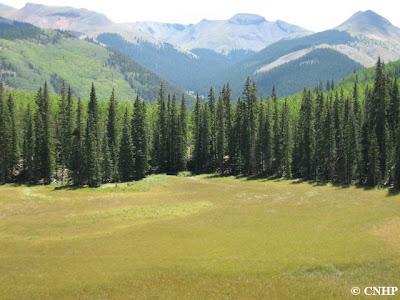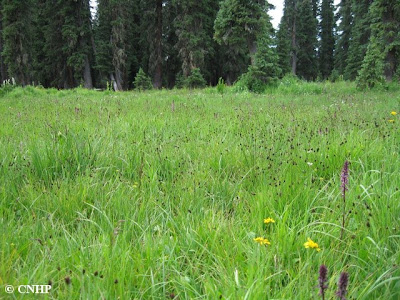CNHP ecologist Denise Culver and her colleagues spent a good part of the summer in Jackson County in north-central Colorado, looking at important wetlands of the North Platte watershed. The study was funded by the
North Platte Basin Roundtable and the
Colorado Water Conservancy Board and was designed to assist the Roundtable’s Non-consumptive Needs Assessment committee in meeting their overall goal of identifying important non-consumptive uses in the watershed. “Non-consumptive use” means water used to support wildlife, recreation (fishing, hunting, wildlife viewing, boating) and habitat, as opposed to “consumptive use” which has historically been used to mean water used for agricultural, municipal and industrial benefits.
Denise digging a soil pit, or a mud pit, as the case may be.
The survey will provide the citizens of the North Platte River Watershed with scientific data on the range of wetland dependent plants and animals. These results can be used to assist land use planning and management efforts and to balance the needs of natural resources and water developments. Additionally, the results from individual properties can be utilized by the landowners as a baseline for future conservation options.
A family of badgers wonders what an old survey flag is doing in the middle of their territory (sorry guys).
The North Platte watershed supports every wetland type known in the Southern Rocky Mountain ecoregion, including riparian wetlands (willow carrs), fens (peat accumulating and ground water fed), alkaline flats, and freshwater marshes. These wetland complexes are presently intact and contiguous, providing migration corridors and habitat for animals (including aquatic vertebrates and invertebrates). Prior to the project, very little was known about the wetlands on private lands within the watershed.
Example of a fen in the North Platte watershed.
A pair of sandhill cranes hanging out in a wet meadow.
Migration corridors are extremely important for these and many other birds.
To date, CNHP has had access to over 186,000 privately owned acres, or about 44% of the private land in the watershed. Preliminary results confirm the importance of private lands that support intact, contiguous wetlands in excellent condition. These wetlands make important contributions to the health of aquatic systems by purifying water, filtering runoff, abating floods, and decreasing erosion, as well as providing habitat for wildlife, fish, waterfowl, and amphibians. During the course of the summer we met many landowners and managers who are concerned about the future of the North Platte and its tributaries. Their best management practices, already in place, indicate good stewardship of their lands and water, which is important not only for their property but also for private and public lands downstream.
A young boreal toad makes a break for its wetland home...
…while a juvenile wood frog contemplates its options.




















































